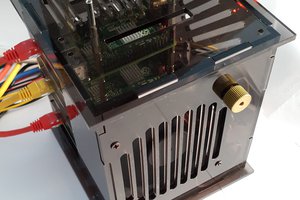Capabilities
- Build to withstand a nuke - I mean, not a direct hit obviously - would probably need a bigger case for that. But it is hardened against the effects of an Electromagnetic Pulse which is a side effect of a nuclear detonation. When the case is closed, it forms a complete conductive shell around the interior electronics. The interior of the case has a double layer of faraday fabric (held in place with rivets and conductive tape). The stock Pelican O-ring was replaced with a conductive gasket and the O-Ring slot was lined with faraday tape, and all potential weak spots were painted over with a water based Nickel conductive paint. Then, the interior was lined with Flex Seal (yeah that guy), to create a rubberized insulation layer, so the shielding isn’t shorted. Lastly, ferrite chokes were placed on many of the wires inside the case as a last line of defense.
- Offline Information Library - Hundreds of GB of information saved to the hard drive (Wikipedia, Medical Cooking recipes, Ted Talks, WikiHow, etc.) saved and served locally via Kiwix
- Offline Navigation and Positioning- World map tiles downloaded and working locally with the embedded GPS antenna
- Signals Intelligence - prebuild SDR apps (just swap antennas)
- Aircraft tracking via ADSB & RTLSDR
- Receive HighRes NOAA weather information and data via GOES geostationary satellites
- AM/FM radio receiver
- Programmable Transmit capability with HackRF
- Offgrid Long Distance Communication - plug in HF antenna and use Digital modes like JS8Call to communicate cross country (potentially internationally) without relying on Cell infrastructure or even satellites.
- Battery & Power - Internal (12Ah) LiFePo4 battery much safer and longer lasting than Li Ion. 3 switchable Power domains to minimize power draw based on use case. Typical lasts >14 hours with no recharge.
- Radiation detection - detection of radiation levels via Nukalert sensor
- Modest compute and extensibility - 2x Raspberry Pi 4Bs with 2x USB 3.0 ports
*Technical Specs moved to components. its a working list im actively updating*
System Design
At a glance - Raspberry Pi v4 as the client, Raspberry Pi v5 as the server, and Teensy 4.1 acting as a microcontroller
ClientPi:
- Handles user interface operations, including keyboard inputs.
- Developing a graphical user interface (GUI) for service control via MQTT.
- Establishes direct connections with truSDX & Digirig through USB, with potential workload delegation to ServerPi.
- Maintains a direct Ethernet connection to the server, bypassing the need for a router with a static IP address.
ServerPi:
- Main memory is 500GB SSD (NVMe) for boot data, map tiles, and file storage. 64GB SD card is utilized, with a dedicated 16GB section configured as swap memory to augment RAM (very useful for bypassing RAM bottleneck for OSRM ! -- more detail to come)
- Orchestrates a master control process via MQTT, primarily functioning as a subordinate to ClientPi by managing micro-services within Docker containers for hardware flexibility.
- Self-powered USB 3.0 hub within an AUX power domain
Teensy 4.1:
- Integrated with a GPS receiver and streaming data to a TFT display. Plans to relay GPS coordinates to ServerPi for navigation.
- Future expansions may include integrating an air quality sensor and additional sensors for enhanced functionality.
Software Services (air-gapped)
Controller*
- Head honcho to run MQTT communication and logging.
Navigation
- Map tiles for the entire planet stored on the SSD. Downloaded for free with OpenStreetMaps! served
- OSRM US west coast (blocked by OOM when i tried any bigger - yes even with 8Gb RAM and 16GB Swap mem). Provides point-to-point routing services for the US West Coast through OSRM.
- ***[enters fantasy] 30cm-resolution satellite imagery [exits fantasy]
Wiki
- Running Kiwix server, to host >250GB of .zim files utilizing straight from the SSD
ADSB
- Pretty...
 Eric B
Eric B





 Robert
Robert
 Cloud4RPi
Cloud4RPi
 Boardman
Boardman
 Jovan
Jovan
why not faraday box? , why not 18650 AND lipo AND solar panel (step up-down from 1V to 24V for other source power)